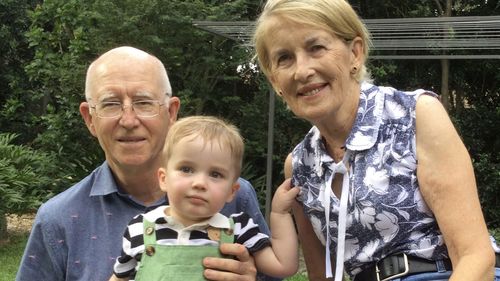<div class="block-content"><div class="styles__Container-sc-1ylecsg-0 goULFa"><span>When Sydney woman Lee Hunt was diagnosed with an aggressive breast cancer back in 2005, she underwent gruelling rounds of chemotherapy and radiotherapy.</span></div></div><div class="block-content"><div class="styles__Container-sc-1ylecsg-0 goULFa"><span>She also began taking what was a relatively new and promising targeted therapy drug at the time, Herceptin, which has been shown to boost the effects of chemotherapy.</span></div></div><div class="block-content"><div class="styles__Container-sc-1ylecsg-0 goULFa"><span>Little did Hunt know that the very treatments that likely saved her life would lead to serious health problems down the track.</span></div></div><div><div id="adspot-mobile-medium"></div></div><div class="block-content"><div class="styles__Container-sc-1ylecsg-0 goULFa"><strong><span>READ MORE:</span></strong><span> </span><a href="https://www.9news.com.au/national/four-day-work-week-australian-council-of-trade-unions/1eabc315-fe5b-4c2b-9822-a8927ad2c9ba" rel="" target="" title="Unions are calling for a four-day week, but some sectors don't agree"><strong><span>Unions are calling for a four-day week, but some sectors don't agree</span></strong></a></div></div><div class="block-content"><div class="styles__Container-sc-1ylecsg-0 goULFa"><span>Five years after finishing her cancer treatments, she began to notice strange symptoms.</span></div></div><div class="block-content"><div class="styles__Container-sc-1ylecsg-0 goULFa"><span>"I just started fainting, and feeling very dizzy," Hunt said.</span></div></div><div class="block-content"><div class="styles__Container-sc-1ylecsg-0 goULFa"><span>Hunt was referred to a haematologist by her GP, on the assumption that it might be her low blood pressure causing the problem.</span></div></div><div><div class="OUTBRAIN" data-reactroot="" data-src="//www.9news.com.au/national/lee-survived-breast-cancer-thanks-to-chemotherapy-years-later-that-treatment-threw-her-a-curveball/c4200d74-33ae-4696-8ef4-5fa94df18db6" data-widget-id="AR_5"></div></div><div class="block-content"><div class="styles__Container-sc-1ylecsg-0 goULFa"><span>Luckily, the hematologist was aware of growing evidence of breast cancer survivors developing heart problems after taking Herceptin.</span></div></div><div class="block-content"><div class="styles__Container-sc-1ylecsg-0 goULFa"><span>Hunt was sent to see a cardiologist, who diagnosed her with cardiotoxity, which refers to long-term damage to the heart caused by a medical treatment.</span></div></div><div class="block-content"><div class="styles__Container-sc-1ylecsg-0 goULFa"><span>Hunt isn't alone, with data showing heart disease related to cancer treatment is emerging as a significant threat to breast cancer survivors.</span></div></div><div class="block-content"><div class="styles__Container-sc-1ylecsg-0 goULFa"><span>It is now estimated that up to 30 percent of breast cancer patients who undergo chemotherapy will go on to develop potentially life-threatening heart complications as a side effect of associated targeted therapies, immunotherapies or the chemotherapy itself.</span></div></div><div class="block-content"><div class="styles__Container-sc-1ylecsg-0 goULFa"><span>Australian scientists at the Heart Research Institute hope to have a solution to the problem soon, in the form of a new drug that patients can take while undergoing chemotherapy to prevent heart damage.</span></div></div><div class="block-content"><div class="styles__Container-sc-1ylecsg-0 goULFa"><span>Professor Julie McMullen leads a team of researchers at the institute who have earmarked two potential drugs which have been showing promise.</span></div></div><div class="block-content"><div class="styles__Container-sc-1ylecsg-0 goULFa"><span>The drugs are being tested on revolutionary "mini-hearts" created in the lab.</span></div></div><div class="block-content"><div class="styles__Container-sc-1ylecsg-0 goULFa"><span>The size of a grain of sand, these tiny hearts are made from donated human blood, and have their own heartbeat.</span></div></div><div class="block-content"><div class="styles__Container-sc-1ylecsg-0 goULFa"><span>The tiny heart model was developed in the laboratory of University of Technology Associate Professor Carmine Gentile in an Australian first.</span></div></div><div class="block-content"><div class="styles__Container-sc-1ylecsg-0 goULFa"><span>"We can collect blood from breast cancer patients, and then isolate their cells, and with those cells, we can make these little mini hearts," McMullen said. </span></div></div><div class="block-content"><div class="styles__Container-sc-1ylecsg-0 goULFa"><span>"Then, if we put some cancer drugs onto them, we can see if that impacts how they beat. </span></div></div><div class="block-content"><div class="styles__Container-sc-1ylecsg-0 goULFa"><span>"We can also test whether one of our protective drugs protects them against any defects in how they beat."</span></div></div><div class="block-content"><div class="styles__Container-sc-1ylecsg-0 goULFa"><span>The ambitious cardio-oncology project also aims to understand why some patients are more susceptible to cardiotoxicity than others, helping pave the way for more personalised treatment in the future.</span></div></div><div class="block-content"><div class="styles__Container-sc-1ylecsg-0 goULFa"><span>"We currently have limited knowledge on why cardiotoxicity occurs and which women will be most impacted," McMullen said.</span></div></div><div class="block-content"><div class="styles__Container-sc-1ylecsg-0 goULFa"><span>"This research has the opportunity to identify women at risk of cardiotoxicity before symptoms are present, so we can develop drugs to protect the heart during and after cancer treatment."</span></div></div>
A new drug helped Lee survive breast cancer. Then she was thrown a curveball

Leave A Reply
Your email address will not be published.*